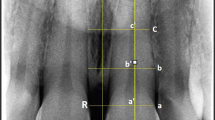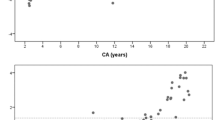Abstract
Introduction
Methods based on pulp/tooth ratios proposed by Kvaal et al. (1995) have been widely used for age estimation in adults. The tendency of age estimates to mimic the age structure of the reference population, i.e. age mimicry bias, is a possible source of controversy in the results of studies. The primary objective of the present study was to evaluate the effect of age mimicry bias on the accuracy of the original Kvaal’s method and its recent modification proposed by Roh et al. (2018).
Method and material
The study sample comprised 240 cone-beam computed tomography scans of an Iranian population. The bootstrap procedure was used to study the impact of age mimicry bias on age estimates by constructing reference populations with different age structures. The accuracy of Kvaal’s and Roh’s variables for age estimation was assessed using a twofold cross-validation technique and principal component analysis.
Results
The application of original equations resulted in SEE values highly greater than the acceptable threshold for forensic purposes (10 years). The population-specific equations obtained SEE values of 9.18, 11.03, and 9.22 years using Kvaal’s variables and 9.19, 11.13, and 9.14 years using Roh’s variable for the maxillary, mandibular, and all teeth, respectively. The bootstrap procedure revealed that using uneven reference populations to formulate the equation resulted in significantly greater SEEs (almost all >10 years) that were not acceptable for forensic purposes. Moreover, using an older (a younger) reference population contributed to a sharp rise in the amount of over- (under-) estimation for younger (older) age groups.
Conclusion
Age mimicry bias had an undesirable impact on the accuracy of dental age estimation based on Kvaal’s and Roh’s methods. The accuracy of the original equations was low for age estimation in the Iranian sample. However, the performance of the population-specific equations was reasonably acceptable for the maxillary and all six teeth.

Similar content being viewed by others
Data availability
The data and material will be sent upon the journal request.
Code availability
Not applicable
References
Senn DR, Weems RA (2013) Manual of forensic odontology, 5th edn. CRC Press, Boca Raton, FL
Wittwer-Backofen U, Gampe J, Vaupel JW (2004) Tooth cementum annulation for age estimation: results from a large known-age validation study. Am J Phys Anthropol 123(2):119–129
Wochna K, Bonikowski R, Śmigielski J, Berent J (2018) Aspartic acid racemization of root dentin used for dental age estimation in a Polish population sample. Forensic Sci Med Pathol 14(3):285–294
Arany S, Ohtani S, Yoshioka N, Gonmori K (2004) Age estimation from aspartic acid racemization of root dentin by internal standard method. Forensic Sci Int 141(2-3):127–130
Movahedian N, Abedi S, Memarpour M (2018) Comparison of the Demirjian and root resorption methods to estimate dental age in radiographic images. J Dent Child 85(2):45–50
Demirjian A, Goldstein H, Tanner J (1973) A new system of dental age assessment. Hum Biol 45:211–227
Gustafson G, Koch G (1974) Age estimation up to 16 years of age based on dental developement. Odont Revy 25:297–306
Olze A, Schmeling A, Taniguchi M, Maeda H, van Niekerk P, Wernecke K-D, Geserick G (2004) Forensic age estimation in living subjects: the ethnic factor in wisdom tooth mineralization. Int J Legal Med 118(3):170–173
Cameriere R, Ferrante L, Cingolani M (2004) Variations in pulp/tooth area ratio as an indicator of age: a preliminary study. J Forensic Sci 49(2):1–3
Kvaal SI, Kolltveit KM, Thomsen IO, Solheim T (1995) Age estimation of adults from dental radiographs. Forensic Sci Int 74(3):175–185
Cameriere R, De Luca S, Egidi N, Bacaloni M, Maponi P, Ferrante L, Cingolani M (2015) Automatic age estimation in adults by analysis of canine pulp/tooth ratio: preliminary results. J Forensic Radiol Imaging 3(1):61–66
Erbudak HÖ, Özbek M, Uysal S, Karabulut E (2012) Application of Kvaal et al.’s age estimation method to panoramic radiographs from Turkish individuals. Forensic Sci Int 219(1-3):141–146
M-j L, Chu G, M-q H, Chen T, Zhou H, Guo Y-c (2019) Application of the Kvaal method for age estimation using digital panoramic radiography of Chinese individuals. Forensic Sci Int 301:76–81
Bosmans N, Ann P, Aly M, Willems G (2005) The application of Kvaal's dental age calculation technique on panoramic dental radiographs. Forensic Sci Int 153(2-3):208–212
Landa M, Garamendi P, Botella M, Alemán I (2009) Application of the method of Kvaal et al. to digital orthopantomograms. Int J Legal Med 123(2):123–128
Meinl A, Tangl S, Pernicka E, Fenes C, Watzek G (2007) On the applicability of secondary dentin formation to radiological age estimation in young adults. J Forensic Sci 52(2):438–441
Karkhanis S, Mack P, Franklin D (2014) Age estimation standards for a Western Australian population using the dental age estimation technique developed by Kvaal et al. Forensic Sci Int 235:104. e101–104. e106
Penaloza TYM, Karkhanis S, Kvaal SI, Nurul F, Kanagasingam S, Franklin D, Vasudavan S, Kruger E, Tennant M (2016) Application of the Kvaal method for adult dental age estimation using Cone Beam Computed Tomography (CBCT). J Forensic Legal Med 44:178–182
Akay G, Gungor K, Gurcan S (2019) The applicability of Kvaal methods and pulp/tooth volume ratio for age estimation of the Turkish adult population on cone beam computed tomography images. Aust J Forensic Sci 51(3):251–265
Paewinsky E, Pfeiffer H, Brinkmann B (2005) Quantification of secondary dentine formation from orthopantomograms—a contribution to forensic age estimation methods in adults. Int J Legal Med 119(1):27–30
Cameriere R, De Luca S, Alemán I, Ferrante L, Cingolani M (2012) Age estimation by pulp/tooth ratio in lower premolars by orthopantomography. Forensic Sci Int 214(1-3):105–112
Maret D, Peters OA, Dedouit F, Telmon N, Sixou M (2011) Cone-Beam Computed Tomography: a useful tool for dental age estimation? Med Hypotheses 76(5):700–702
B-y R, Lee W-J, Ryu J-W, Ahn J-M, Yoon C-L, Lee S-S (2018) The application of the Kvaal method to estimate the age of live Korean subjects using digital panoramic radiographs. Int J Legal Med 132(4):1161–1166
Bocquet-Appel J-P, Masset C (1982) Farewell to paleodemography. J Hum Evol 11(4):321–333
Masset C (1989) Age estimation on the basis of cranial sutures. In: Iscan MY (ed) Age markers in the human skeleton. Charles C. Thomas, Springfield, pp 71–104
Konigsberg LW, Frankenberg SR, Walker RB (1997) Regress what on what? Paleodemographic age estimation as a calibration problem. In: Paine RR (ed) Integrating archaeological demography: multidisciplinary approaches to prehistoric population. Southern Illinois University, Carbondale, pp 64–88
Konigsberg LW, Frankenberg SR (1992) Estimation of age structure in anthropological demography. Am J Phys Anthropol 89(2):235–256
Rolseth V, Mosdøl A, Dahlberg PS, Ding Y, Bleka Ø, Skjerven-Martinsen M, Straumann GH, Delaveris GJM, Vist GE (2019) Age assessment by Demirjian’s development stages of the third molar: a systematic review. Eur Radiol 29(5):2311–2321
Kanchan-Talreja P, Acharya AB, Naikmasur VG (2012) An assessment of the versatility of Kvaal's method of adult dental age estimation in Indians. Arch Oral Biol 57(3):277–284
Haghnegahdar A, Vossoughi M, Teymoorienik Z, Khojastepour L (2018) Evaluating the accuracy of Kvaal’s method for age estimation in a selected Iranian population. J Dent Biomater 5(2):573–582
Patil SK, Mohankumar K, Donoghue M (2014) Estimation of age by Kvaal's technique in sample Indian population to establish the need for local Indian-based formulae. J Forensic Dent Sci 6(3):166–170
Mittal S, Nagendrareddy SG, Sharma ML, Agnihotri P, Chaudhary S, Dhillon M (2016) Age estimation based on Kvaal's technique using digital panoramic radiographs. J Forensic Dent Sci 8(2):115
Acknowledgements
The authors thank the Vice-Chancellory of Shiraz University of Medical Sciences for supporting this research (Grant# IR.Sums.Dental.REC.1398.087). This manuscript is based on the thesis by Dr Alireza Ghafoori.
Funding
Shiraz University of Medical Sciences
Author information
Authors and Affiliations
Contributions
All authors contributed to the study conception and design. Material preparation, data collection and analysis were performed by Najmeh Movahhedian, Mehrdad Vossoughi, and Alireza Ghafoori. The first draft of the manuscript, revision and edition was done by Najmeh Movahhedian and Mehrdad Vossoughi. All authors read and approved the final manuscript.
Corresponding author
Ethics declarations
Ethics approval and consent to participate
Human Ethics Review Committee of the Faculty of Dentistry, University of Medical Sciences, Shiraz, Iran (#IR.Sums.Dental.REC.1398.087). The images were taken for various purposes other than the present study and written informed consent had been obtained from all the patients at the time of exposure for the possible use of their anonymous information in future researches.
Consent for publication
The authors transfer to the publisher the non-exclusive publication rights
Conflict of interest
The authors declare no competing interests.
Additional information
Publisher’s note
Springer Nature remains neutral with regard to jurisdictional claims in published maps and institutional affiliations.
Rights and permissions
About this article
Cite this article
Vossoughi, M., Movahhedian, N. & Ghafoori, A. The impact of age mimicry bias on the accuracy of methods for age estimation based on Kvaal’s pulp/tooth ratios: a bootstrap study. Int J Legal Med 136, 269–278 (2022). https://doi.org/10.1007/s00414-021-02651-7
Received:
Accepted:
Published:
Issue Date:
DOI: https://doi.org/10.1007/s00414-021-02651-7




